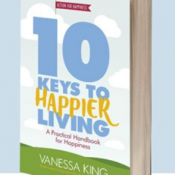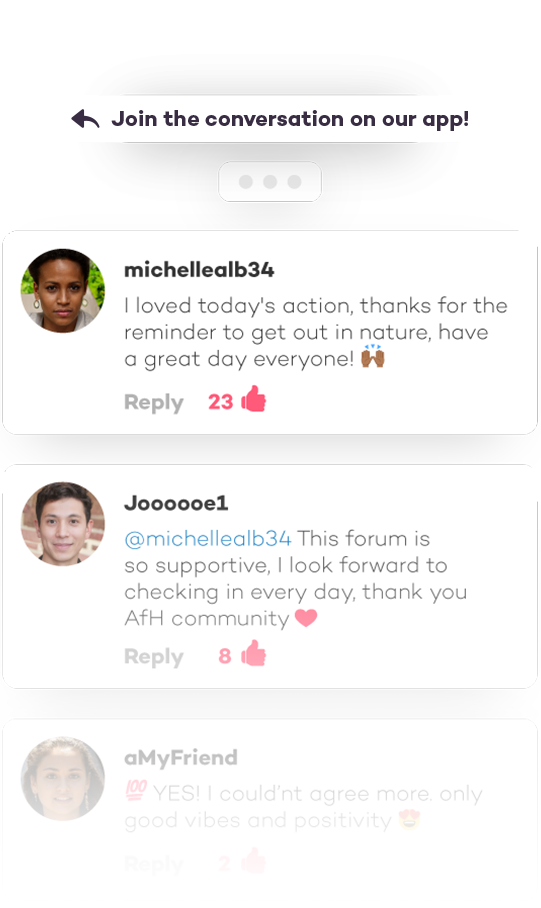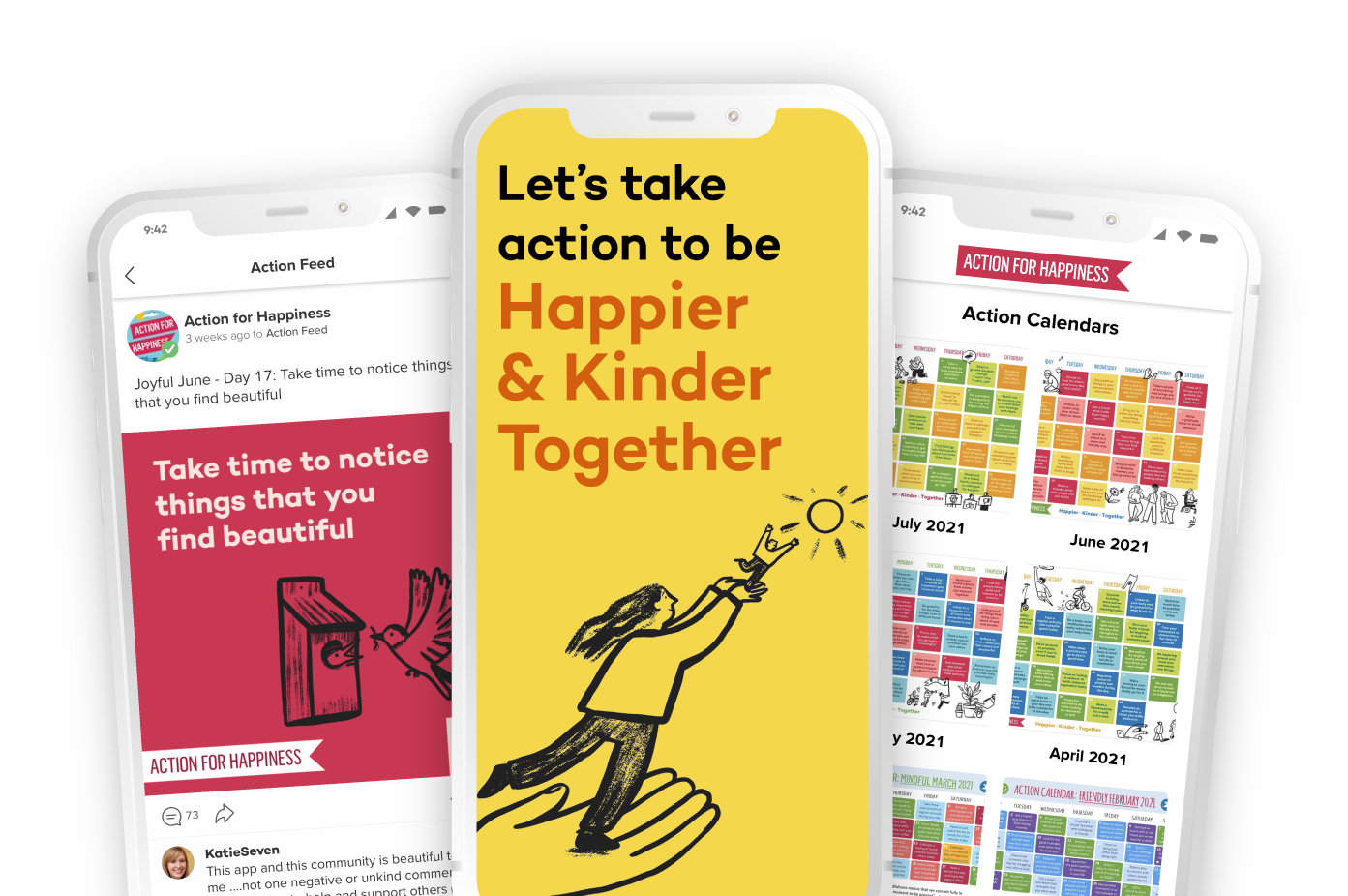Resilience
Find ways to bounce back
Everyone has ups and downs - difficulties are part of life for us all. Science shows we can learn skills, actions and habits of thinking that boost our natural resilience.
We all experience small daily frustrations and everyday stresses and at times, bigger upsets, failures, unexpected change and challenges. Many of us will also experience traumatic events at some point in our lives such as the loss of someone we love, the sudden loss of our job, an accident or serious illness. Being resilient doesn’t mean we will never feel pain, upset, hurt, sadness, fear or anger when we experience difficult times. It means in the moment or over time we can find ways to cope constructively, accept what has happened, adapt and eventually move forward.
Research shows that resilience isn’t a rare quality found in a few, extraordinary people. Dr Ann Masten, a leading expert in resilience, describes it as ‘ordinary magic’ comprising many factors, internal and external, including our everyday capabilities, relationships and resources. It’s not a static characteristic – it varies for all of us. We can each be naturally resilient in some situations or times in our lives and not others.
Importantly many studies from psychology, neuroscience, medicine and other fields show that we can learn skills, practices and habits of thinking that can help to boost and build our resilience. So although life may have unexpected twists and turns, we can develop our skillset and nurture our internal and external resources to help us respond flexibly, effectively deal with challenges, recover more quickly and even learn as a result. This can lower our risk of depression and anxiety and even enable us to age successfully. What’s more the same skills can help us manage the fear of taking on new opportunities and so help us develop and grow in other ways too.
Why not take action right now? Join Abi, our coach from the 10 Days of Happiness program, for a short video and a quick activity to help you build your bouncebackability.
Active coping
We can’t always predict or control what life throws at us, but there is always something we can try, even if it’s tiny. Active coping involves acknowledging the difficulties we are experiencing and finding something constructive to try to make today or tomorrow slightly better, rather than avoiding our problems. This act of trying in itself, doing something rather than feeling there’s nothing we can do, helps us to cope, find and maintain hope and to feel effective. It helps us to feel we at least have some control, even if what we do seems inconsequential.
Having a sense of control is essential for our wellbeing. When we experience difficult times we can feel powerless but whatever the situation, there is nearly always something we can try – whether that’s an external action or something internal. As psychiatrist and concentration camp survivor, Dr. Viktor Frankl famously said “Everything can be taken from a [person] but one thing: the last of the human freedoms – to choose one’s attitude in any given set of circumstances.”
Active coping isn’t about ignoring our problems or struggles but taking constructive action despite them. All of the 10 Keys to Happier Living have actions and ideas that can help during difficult times. Importantly, remember you don’t need to struggle alone. Reaching out and asking for help when you need it, whether from people you know well or in your local community or from specialist help organisations, is being resilient. Keep in mind that everyone has difficulties sometimes and when someone helps us it has wellbeing benefits for you both.
Try it: Reflect back on a challenging or difficult time in your life. What helped you cope and come through it? How could that help you today?


Investing in our Resilience
Regularly taking action to boost and maintain your happiness and wellbeing is an investment in your resilience too. It can mean you are more able to cope and deal with stressful or challenging situations when they happen.
Nurturing your relationships with others, knowing who you can turn to for support when you have difficulties and exercising and taking care of your body in other ways like getting enough sleep, eating properly and not numbing ourselves with alcohol or in other ways, are especially vital.
Noticing good things that happen, however small; cultivating a sense of realistic optimism or a hopeful outlook, even in dark times; trying out new things and being clear on what really matters and is meaningful for you – are all important sources of resilience too.
Reflection: What actions help you maintain and build your resilience? Who are people you can turn to when you are struggling? How do you maintain and nurture your connections to them?
Resilient thinking – our thoughts drive our emotions
The way we think has a significant impact on how we feel, and how we feel impacts what we say and do in response, which has consequences for our interactions with others and how happy and resilient we are.
When an event or situation triggers an emotional reaction in us – for example fear or anger - we attribute that emotion to the trigger. But preceding our emotion will be instant, underlying thoughts or beliefs about the trigger – for example, “I’m in danger” or “That’s unfair”. It’s actually our underlying thoughts that trigger our emotions. This all happens so fast we don’t realise we’ve had these thoughts, but we can learn to tune into them. Importantly, our in-the-moment thoughts often aren’t accurate because they happen so fast. They aren’t facts, even though we often respond as if they are - in so doing, we cause ourselves to feel more anger, upset and hurt than we might need to.
Learning to check in and challenge our instant thoughts helps us manage our emotions and the reactions that result. We can have more choice and control over our instant interpretations than our instinctive emotional reactions.
Often our instant thoughts to a trigger will be about why something happened (e.g. “I must have done something wrong” or “they don’t like me” or that what will happen next (e.g. “I’ll get in trouble” or “I’ll be rejected”). We often jump to instant negative or worst-case interpretations. This is because our human brain evolved to keep us physically safe (see the Key of Emotions for more on this), by being on alert for potential downsides and risks. It will jump to conclusions about potential dangers and err on the side of caution by negatively interpreting neutral or ambiguous interactions or things that happen to us.
Instant interpretations of potential risk, such as danger or violation, activate the threat system in our primitive emotional brain. So when these instant beliefs are inaccurate (as they often are), we will feel unpleasant emotions unnecessarily. In turn, this impacts what we say or do next, setting off a chain reaction of further thoughts, emotions and reactions and impacting our interactions with others. In this way, we can actually undermine our own resilience without realising it!
For example, we are walking down the street and see someone we know so we call out or wave to them but they don’t respond. Our instant beliefs or interpretation of the situation might be “They’re ignoring me, how rude” or “They don’t like me.” This causes us to feel hurt or upset and perhaps then to be off-hand with the next person we meet. In that situation, we couldn’t know for sure what was going on for that person and whether they saw us or not. It could be they were lost in thought or worries, in a rush or even have poor eyesight! When we learn to check in to the instant thoughts underlying them and learn to challenge these for accuracy, we can stop the potential spiral of unhelpful, unpleasant emotions and subsequent actions. So in our example above, we might give the person the benefit of the doubt which means we don’t feel upset or offended and carry that on into our day.
So when something triggers an unpleasant emotional reaction in you, a first step in more resilient thinking is to take a brief pause, breathe and check in on your instant interpretations. Ask yourself “Are my instant beliefs accurate or is another, less upsetting interpretation possible?” Learning to do this can benefit you and your relationships with others!
Reflection: Think back to a time when you jumped to an instant negative conclusion about someone or something that happened (keep it to a small example)? What were your in-the-moment thoughts about why it happened? How did that cause you to feel and what did you do as a result? What might have been an alternative, less negative, interpretation at that time? How would that have led you feel and act?


Resilient thinking – Watch out for thinking traps
Once we start to notice our instant thoughts and interpretations that trigger an emotional reaction in us, we might start to notice themes. It’s very common for many of us to have habitual patterns of interpretation we can fall into that undermine our resilience and even lead to depression and anxiety, especially when we are tired, stressed or overwhelmed. These are often called ‘thinking traps’, because they cause us to interpret the situation in a particular, negative way and then, when we’ve jumped to our instant interpretation, we start to look for more evidence to support our thoughts and ignore evidence that is counter to them (this is called confirmation bias).
There are lots of possible thinking traps. Some common ones include:
Blaming ourselves – believing we’re at the root cause of anything that goes wrong.
Believing it’s permanent – when something bad happens we think “That’s it – it will always be like this, there’s nothing I can do”.
Believing it will ripple out – when something difficult happens in one part of our life we instantly think that other aspects of our life will go wrong too.
Blaming others – believing that our difficulties and problems are all caused by others.
All or nothing thinking (sometimes called black and white thinking) - Interpreting something or someone as all bad or all good instead of seeing possible shades of in-between.
Mind-reading – assuming you know what others are thinking or expecting.
Mis-labelling – judging yourself or others on the basis of a single or narrow situation.
Shoulds – having fixed beliefs about what we or others should/ought to/must do.
Magnification or Minimisation – over- or underplaying the meaning, importance or likelihood of things.
Emotions as facts – believing that if we feel something it’s true.
Catastrophisation – spiralling to the worst possible scenario, even if this is extremely unlikely.
The first step to countering our thinking traps is start to notice when we fall into them and then we can learn to challenge these thoughts. For example by asking ourselves questions like:
“What is the evidence this is true?”
“What evidence is there that suggests it might not be true?”
“What is a different way of thinking about this situation?”
Try it: Looking at the list of common thinking traps above, do you recognise one you have a tendency at times to fall into? How can you challenge those thoughts next time you do?
Resources
1 American Psychological Association (2020) https://www.apa.org/topics/resilience
2 Masten, A.S. (2001). Ordinary magic. Resilience processes in development. American Psychologist, 56, 227-238.
3 Masten, A.S, & Wright, M.O. (2010). Resilience over the lifespan: Developmental perspectives on resistance, recovery and transformation. Handbook of Adult Resilience, 213-237.
4 Southwick, S.M. & Charney, D.S. (2018). Resilience – The Science of Mastering Life’s Greatest Challenges. Cambridge.; Reivich, K & Shatté, A. (2003). The Resilience Factor: Seven keys to finding your inner strength and overcoming life’s hurdles. NY: Broadway Books
5 Reivich, K & Shatté, A. (2003). The Resilience Factor: Seven keys to finding your inner strength and overcoming life’s hurdles. NY: Broadway Books; Tedeschi, R.G. & Calhoun, L.G.(2004). Posttraumatic Growth: Conceptual Foundations and Empirical Evidence, Psychological Inquiry,15,1-18; Masten, A.S., Cutuli, J.J., Herbers, J.E. & Reed, M.J. (2009). Resilience in Development. In Eds: S.J. Lopez, & C.R. Snyder, Oxford Handbook of Positive Psychology. NY:Oxford University Press
6 Wu, G., Feder, A., Cohen, H., Kim, J. J., Calderon, S., Charney, D. S., & Mathé, A. A. (2013). Understanding resilience. Frontiers in Behavioral Neuroscience, 7, 10.; Southwick SM, Vythilingam M, Charney DS. (2005) The psychobiology of depression and resilience to stress: implications for prevention and treatment. Annual Review of Clinical Psychology. 1:255–291.
7 Ryan, R. M., & Deci, E. L. (2017). Self-determination theory: Basic psychological needs in motivation,
development, and wellness. Guilford Publications.
8 Frankl, V. (1959, 2004) Man’s Search for Meaning. Rider Books. Pp.75
9 Wu, G., Feder, A., Cohen, H., Kim, J. J., Calderon, S., Charney, D. S., & Mathé, A. A. (2013). Understanding resilience. Frontiers in Behavioral Neuroscience, 7, 10
10 Reivich, K & Shatté, A. (2003). The Resilience Factor: Seven keys to finding your inner strength and overcoming life’s hurdles. NY: Broadway Books
11 Reivich, K & Shatté, A. (2003). The Resilience Factor: Seven keys to finding your inner strength and overcoming life’s hurdles. NY: Broadway Books
12 https://www.nhs.uk/mental-health/conditions/post-traumatic-stress-disorder-ptsd/overview/
13 Tedeschi, R.G. & Calhoun, L.G.(2004). Posttraumatic Growth: Conceptual Foundations and Empirical Evidence, Psychological Inquiry,15,1-18
14 Joseph, S. (2011) What Doesn’t Kill Us: The New Science of Posttraumatic Growth. Piatkus.
15 Joseph, S. (2011) What Doesn’t Kill Us: The New Science of Posttraumatic Growth. Piatkus.


Take the 10 Keys to Happier Living online coaching programme.










